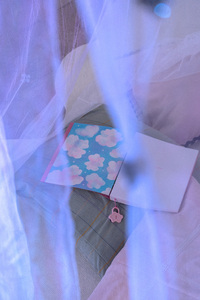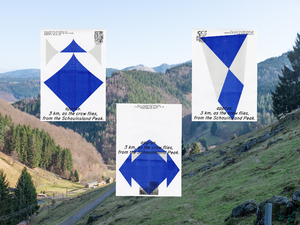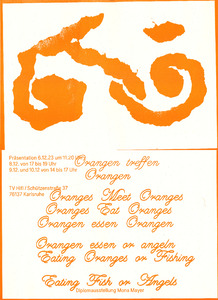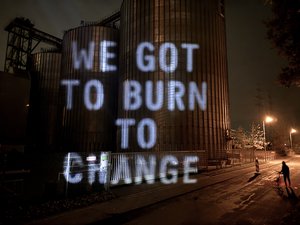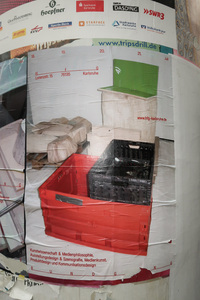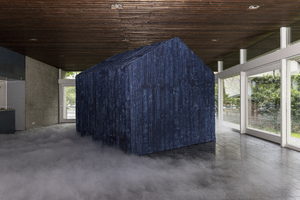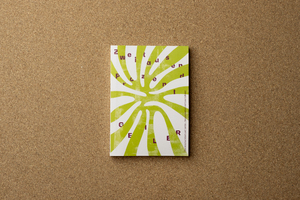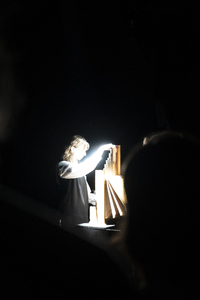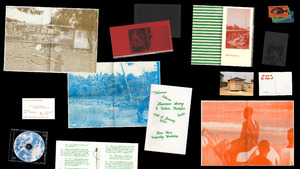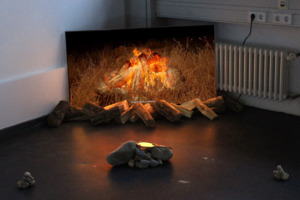Line-Gry Hørup
| Name | Line-Gry Hørup |
18 Inhalte
- Seite 1 von 2
Cooking Care
- Titel
- Cooking Care
- Autor/in
- Beschreibung (de)
- Welche Art von unbezahlter Sorgearbeit leistest du?
Fühlst du dich dafür wertgeschätzt?
Würdest du dir mehr Hilfe von Familienmitgliedern oder Freund*innen wünschen?
Die szenische Installation „Cooking Care“ zeigt eine pflanzen gefärbte Patchwork-Tischdecke, die die Geschichten von Valeria, Susanne, Anna, Heike und Anne und deren unbezahlten Sorgearbeit über eine Woche hinweg in sich aufgesogen hat. Sie möchte die unsichtbare Arbeit sichtbar machen, investierte Zeit würdigen und sie feiern. Sie bietet eine Bühne, um ihre Stimmen zu hören, Verbindungen zu knüpfen und sich gegenseitig zu unterstützen.
Ausgangspunkt dieses Projekts war ein Abendessen mit fünf Frauen, die in verschiedenen Bereichen der unbezahlten Sorgearbeit tätig sind. An diesem Abend war das Kochen eine gemeinsame Aufgabe, die es allen ermöglichte, nicht nur den Prozess und das gemeinsame Essen zu genießen, sondern auch sich umeinder zu sorgen. Es wurde eine Reihe von vorbereiteten Fragen gestellt, um einen Raum für den Austausch von Geschichten, Zweifeln und Erfahrungen zu schaffen.
Darüber hinaus wurden die Teilnehmer ermutigt, die Stunden unbezahlter Sorgearbeit, die sie in den nächsten sieben Tagen leisteten, zu dokumentieren; sie sollten konkrete Zahlen auf Papier bringen, um die Stunden sowohl für sich selbst als auch für andere sichtbar zu machen. Sie wurden auch gebeten, die psychische Belastung zu dokumentieren, die sie in dieser Zeit erfahren haben. Anschließend wurden die dokumentierten Stunden unterschiedlicher Sorgearbeit und die entsprechende psychische Belastung in eine abstrakte Infografik – in Form einer Tischdecke – übersetzt.
Die Tischdecke besteht aus mehreren gleich großen Quadraten, die jeweils eine Stunde unbezahlter Pflegearbeit repräsentieren, die von diesen fünf Frauen im Laufe der sieben Tagen dokumentiert wurde. Die einzelnen Stoffstücke wurden mit essbaren, saisonalen und lokal beschafften Pflanzen gefärbt, von denen viele selbst gesammelt wurden. Sie wurden vorbehandelt und 24 bis 48 Stunden lang im Färbebad gekocht. Da es sich bei den Stoffen um gebrauchte Haushaltstextilien handelt, hat jedes Stück seine eigene Geschichte und variiert in seiner Fähigkeit, Farbe zu absorbieren. Daher war der Färbeprozess experimentell und variierte, was jedes Mal zu einem einzigartigen Ergebnis führte. Außerdem trug der unterschiedliche Wuchs der zum Färben verwendeten Pflanzen zur Vielfalt der Ergebnisse bei.
Jede gefärbte Farbnuance steht für eine andere Art von Pflegearbeit. Bei hoher psychischer Belastung wurden die Quadrate mit zusätzlichem Stoff durch die Quilting Technik verdickt. Die so entstandene Tischdecke dient somit als künstlerische Abstraktion der unbezahlten Sorgearbeit, die ihre Sichtbarkeit erhöhen soll.
- Welche Art von unbezahlter Sorgearbeit leistest du?
- Beschreibung (en)
- What kind of unpaid care work are you doing?
Do you feel appreciated for it?
Would you like to have more help from family members or friends?
The spatial installation 'Cooking Care' shows a plant-dyed patchwork tablecloth soaked in the stories of Valeria, Susanne, Anna, Heike und Anne and their unpaid care-workload of one week. It aims to reach visibility, to celebrate, and appreciate the time and effort put into that work, and to give their voices a stage to be heard, connected and empowered.
The starting point of this project was a dinner with five women who engage in different fields of unpaid care work. That evening, cooking was a shared task, allowing everyone to not only enjoy the process and feasting together but also to care for each other. A set of premeditated question was asked to create a space to share stories, doubts, and experiences.
Furthermore, the participants were encouraged to document the hours of unpaid care work they performed over the next seven days; to provide actual numbers on paper, making it visible both to themselves and to others. They were also asked to document the mental load they experienced during this time. Then, the documented hours of different care work and the according mental load were translated into an abstract infographic in the form of a tablecloth.
The tablecloth consists of multiple squares of identical size each representing one hour of unpaid care work as documented by these five women over the course of seven days. The individual fabric pieces have been dyed using edible, seasonal, and locally-sourced plants, many of which were self-collected. They were pre-treated and cooked in the dye bath for 24 to 48 hours. Since the fabric consists of second hand household textiles, each piece carries its own history and varies in its ability to absorb dye. Thus, the dyeing process was experimental and varied with each batch, resulting in a unique outcome every time. The different growth of the plants used for dyeing added to the variety.
Each dyed color shade stands for a different type of care work. When there was a high mental load reported, squares were also thickened with additional fabric by the quilting technique. The resulting tablecloth thus serves as an artistic abstraction of the unpaid care work that aims to increase its visibility.
- What kind of unpaid care work are you doing?
- Kategorie
- Typ des Projekts/Werks
- Schlagworte
- Datierung
- 14.01.2025 - 21.01.2025
- Mitwirkende
- Dank an
- Eike Buff
- Jaya Demmer
- Lina Determann
- Nele Faust
- Miki Feller
- Ricarda Fischer
- Severin Geißler
- Laura Haak
- Laurine Haller
- Noa Haller
- Line-Gry Hørup
- Anne Duk Hee Jordan
- Leonie Junker
- Florian Knöbl
- Hanne König
- Susanne Kriemann
- Jannik Lang
- James Langdon
- Helene Lauppe
- Yun-Wen Liu
- Nini Lue
- Mona Mayer
- Leonie Mühlen
- Kamilla Murtazina
- Kamilla Murtazina
- Kathrin Rüll
- Tereza Ruller
- Jette Schwabe
- Isabel Seiffert
- Merve Şimşek
- Leia Morgana Walz
- Judith Wolff
- Feminist Hiking Collective
- Sprache
- Abmessungen
- 180cm x 66cm x 400cm
- Dauer
- 23:18
- Ort: Institution
- Ort
- Im Innenhof und Garten der Schützenstraße 37, zwischen tv-Hifi, Ateliergemeinschaft und Wohnungen
- Stadt
- Land
- Titel
- Cooking Care
- Importiert am
- 14.11.2024
- Übergeordnete Sets
- 0
- Set enthält
- 0 0
eternal girlhood
- Titel
- eternal girlhood
- Untertitel
- oh my dreams
- Autor/in
- Beschreibung (de)
- “eternal girlhood” ist eine konzeptionelle Arbeit, welche aus einer Rauminstallation und einer Publikation besteht.
Ursprünglich in den Chinesischen Pavillons des Fasanengarten in Karlsruhe installiert, wurden durch Requisiten sowie einem selbst produzierten Musikstück, der Raum mit der Handlung der Publikation, verknüpft.
Das Projekt ermöglicht eine Reise in eine poetische Geschichte, inspiriert von persönlichen und kulturellen Themen wie Girlhood, Coming-of-Age und Growing Pains.
Die Handgebundene Publikation mit glitzerndem und geprägtem Umschlag umfasst auf ca. 100 Seiten neben Serien Analoger Schwarzweiß-Fotografie farbige Mittelformat Fotos, begleitet von analogen Schnappschüssen und Riso gedruckte Illustrationen.
Zwischen Fotoserien und Illustrationen, sind Songtexte sowie Skript-fragmente und Gedichte eingestreut, in Referenz zu Filmsequenzen aus Coming of Age Geschichten. Es ergibt sich die zeitlose Skizze eines Mädchens die Teil einer innig verbundenen Mädchengruppe ist.
Transparente Drucke von drei Mittelformat Fotografien werden vom Fensterlicht erleuchtet und symbolisieren in Zusammenarbeit mit dem Buch unterschiedliche Kapitel der Geschichte.
Unter einem Baldachin, umgeben von funkelnd tanzenden Schmetterlingen können Besucher*innen in diese Welt eintauchen und sind eingeladen, für einen Moment Teil von „eternal girlhood“ zu sein, fernab der Echtzeit.
- “eternal girlhood” ist eine konzeptionelle Arbeit, welche aus einer Rauminstallation und einer Publikation besteht.
- Beschreibung (en)
- “eternal girlhood“ is a conceptional Artwork, blending a publication with its installation space.
Initially installed in the Chinese pavillons of the Fasanengarten in Karlsruhe, the space was connected to the story of the book through props and a musical sound score.
The project offers a journey into a poetic Story, inspired by personal and cultural ideas on girlhood, coming of age and growing pains.
Handbound, wrapped in a glittery embossed Dustcover, the Publication features around 100 Pages with multiple series of black and white film photography, medium format shots underlined by analog snapshots and Riso printed Illustrations. In between the Chapters of Photography and Illustrations, lyrics, fragments of script and poems are inserted in reference to movie sequences from coming of age stories. A timeless profile of a girl being part of girlhood and a deeply connected friendship is created.
Transparent prints of three medium format photos are illuminated by the windows’ natural light and symbolize different chapters of the story in collaboration with the book.
Underneath a canopy, surrounded by sparkling dancing butterflies, Visitors can dive into this World and are invited to become part of “eternal girlhood“, away from modern reality.
- “eternal girlhood“ is a conceptional Artwork, blending a publication with its installation space.
- Kategorie
- Typ des Projekts/Werks
- Schlagworte
- Datierung
- 05.07.2024
- Mitwirkende
- Dank an
- Sprache
- Material
- Technik/Verfahren/Formate
- Risographie Druck, Digitaldruck, Mediumformat Fotografie, Schreibmaschine, Laser, Prägung
- Abmessungen
- Fläche: ca. 5m x 5m, Höhe der Aufhängung ca. 3m
- Ort: Institution
- Ort
- Chinesische Pavilions des Fasanengarten
- Stadt
- Land
- Beteiligte Institution(en)
- Titel
- eternal girlhood
- Projektleiter/in
- Studiengang
- Typ der Abschlussarbeit
- Importiert am
- 05.11.2024
- Übergeordnete Sets
- 1
- Set enthält
- 0 21
approx. 3km, as the crow flies, from the Schauinsland Peak.
- Titel
- approx. 3km, as the crow flies, from the Schauinsland Peak.
- Autor/in
- Beschreibung (de)
- "approx., 3km, as the crow flies, from the Schauinsland Peak." ist ein Zitat aus der Wegbeschreibung zum Zentralen Bergungsort der Bundesrepublik Deutschland (ZBO) aus dem Internationalen Register der Kulturgüter unter besonderem Schutz der UNESCO. Die Wegbeschreibung führt zum Barbarastollen, einem ehemaligen Erzbergbaustollen im Hintertal, nahe der Gemeinde Oberried im Schwarzwald.
Die Ausstellung versammelt Material in verschiedenen Formen, die den Barbarastollen und damit verbundene Aspekte erforschen. Anhand von Artefakten, die bei mehreren Besuchen im und um den Stollen herum gefunden wurden, Fotos, Geschichten, Zeitungsartikeln, E-Mails, Archivdokumenten, Ton- und Videoaufnahmen untersucht die Ausstellung, wie das Archiv im Stollen funktioniert und warum es noch existiert.
Themen wie Sicherheit, atomare Bedrohung, Hierarchien in der Archivauswahl, Langzeitbotschaften, Atomsemiotik, Friedensbewegung in Süddeutschland in den 80er Jahren werden verhandelt. Durch die Zusammenführung verschiedener Perspektiven auf die Idee eines zentralen Bergungsortes wurde ein Raum geschaffen, der die Besucher dazu anregt, sich kritisch mit den angesprochenen Themen auseinanderzusetzen.
- "approx., 3km, as the crow flies, from the Schauinsland Peak." ist ein Zitat aus der Wegbeschreibung zum Zentralen Bergungsort der Bundesrepublik Deutschland (ZBO) aus dem Internationalen Register der Kulturgüter unter besonderem Schutz der UNESCO. Die Wegbeschreibung führt zum Barbarastollen, einem ehemaligen Erzbergbaustollen im Hintertal, nahe der Gemeinde Oberried im Schwarzwald.
- Beschreibung (en)
- "approx., 3km, as the crow flies, from the Schauinsland Peak." is a quote from the route description to the Central Salvation Site of the Federal Republic of Germany (ZBO) from the UNESCO International Register of Cultural Property under Special Protection. The route description leads to Barbarastollen, a former ore mining tunnel in Hintertal, near the municipality of Oberried in the Black Forest.
The exhibition is gathering material of different forms researching the site of the Barbarastollen. Through several site visits inside and around the mine, photographs, stories, newspaper articles, e-mails, archival documents, sound recordings and videos investigate on how the archive works and why it still exists touching on topics of safety, nuclear threat, hierarchies in archive selections, long-time messages, atom semiotics, the peace- movement in south Germany in the 80s.
Through bringing together different perspectives on the idea of the central Salvation Site a room was created to encourage visitors to critically from their own idea on the topics addressed.
- "approx., 3km, as the crow flies, from the Schauinsland Peak." is a quote from the route description to the Central Salvation Site of the Federal Republic of Germany (ZBO) from the UNESCO International Register of Cultural Property under Special Protection. The route description leads to Barbarastollen, a former ore mining tunnel in Hintertal, near the municipality of Oberried in the Black Forest.
- Kategorie
- Typ des Projekts/Werks
- Schlagworte
- Datierung
- 05.07.2024
- Mitwirkende
- Sprache
- Material
- Ort: Institution
- Ort
- Großes Studio
- Stadt
- Land
- Titel
- approx. 3km, as the crow flies, from the Schauinsland Peak.
- Projektleiter/in
- Semester
- Studiengang
- Typ der Abschlussarbeit
- Importiert am
- 04.11.2024
- Übergeordnete Sets
- 0
- Set enthält
- 0 19
Eating Fish Or Angels
- Titel
- Eating Fish Or Angels
- Titel (en)
- Eating Fish Or Angels
- Autor/in
- Beschreibung (de)
- Eating Fish Or Angels umgreift Objekte, Aktionen, Performances
und Installationen, die in einem Prozess von 10 Monaten gesammelt und abschließend in einer Installation zusammengeführt wurden.
Inhalten, Medien und Ephemera aus dem Alltag in der Rolle als Kommunikationsdesignerin werden mit Abstand betrachtet, um sich mit neuem Blick und künstlerischen Mitteln wieder anzunähern. Die darin entstehenden inhärente Rituale, Logiken und Erzählstrukturen erkunden die Grenzen produktiver und unproduktiver, sinnvoller und sinnloser Tätigkeit, sowie verschiedener
Disziplinen, Identitäten und Strukturen.
- Eating Fish Or Angels umgreift Objekte, Aktionen, Performances
- Beschreibung (en)
- Eating Fish Or Angels encompasses objects, actions, performances
and installations that were collected over a period of 10 months and finally brought together in an installation.
Content, media and ephemera from everyday life in her role as a communication designer are viewed from a distance in order to approach them again with a new perspective and artistic means. The inherent rituals, logics and narrative structures that emerge explore the boundaries of productive and unproductive, meaningful and meaningless activity, as well as different disciplines, identities and structures.
- Eating Fish Or Angels encompasses objects, actions, performances
- Kategorie
- Mitwirkende
- Sprache
- Material
- Technik/Verfahren/Formate
- Multimediale Installation, Aktionen, Performances, Ausstellungen, Wortspiele, Sammeln, Archivieren
- Dauer
- Januar bis Oktober 2024 (Prozesszeitraum)
- Titel
- Eating Fish Or Angels
- Projektleiter/in
- Semester
- Studiengang
- Typ der Abschlussarbeit
- Importiert am
- 01.11.2024
- Übergeordnete Sets
- 1
- Set enthält
- 4 1
Letters of Dissent
- Titel
- Letters of Dissent
- Titel (en)
- Letters of Dissent
- Autor/in
- Beschreibung (de)
- Mein Diplomprojekt mit dem Titel „LETTERS OF DISSENT“ hatte zum Ziel, praktische und zugängliche Mittel des nächtlichen Protests zu erforschen. Dieses Projekt, das sich mit der Wechselbeziehung von Geschichtenerzählen und Punk-Einflüssen befasst, soll durch künstlerische Intervention ein Schlaglicht auf soziale und politische Themen werfen. Es handelt sich um selbst geschriebene Erzählungen, die in einer auf optimale Lesbarkeit ausgelegten Schriftart verfasst sind. Die Einfachheit der verwendeten Technik sorgt für Tragbarkeit und Zugänglichkeit. Das Engagement der Gemeinschaft ist integraler Bestandteil des Werks, das sowohl als Lasercut- als auch als 3D-Druckversion vorliegt und als Open-Source-Initiative zur Verfügung gestellt wird. Die Gesamtästhetik ist von auffallender Helligkeit geprägt und schafft eine visuell beeindruckende und deutlich wahrnehmbare Präsenz. Neben der Hauptdiplomarbeit ist es erforderlich, neuere Arbeiten in einer Ausstellung zu präsentieren, in der sorgfältig ausgewählte Projekte vorgestellt werden. In dem Bemühen, das Ausstellungsdesign auf das übergreifende Thema des Diplomprojekts abzustimmen, zielte der Designansatz darauf ab, wesentliche Prinzipien wie Zugänglichkeit, Abfallminimierung und eine ephemere Pop-up-Sensibilität zu verkörpern.
- Beschreibung (en)
- My diploma project titled "LETTERS OF DISSENT," aimed to explore practical and approachable means of protesting during the nighttime. Delving into the interrelation of storytelling and punk influence, this project seeks to cast a spotlight on social and political subjects through artistic intervention. It involves self-written narratives, utilising a font designed for optimal readability. The simplicity of the technique employed ensures portability and accessibility. Community engagement is integral, using both a lasercut and 3D-print version of the work, which is made available as an open-source initiative. The overall aesthetic is marked by striking brightness, creating a visually impactful and overtly noticeable presence. In addition to the primary diploma project, it is required to showcase recent works in an exhibition, featuring carefully chosen projects. In an effort to align the exhibition design with the overarching theme of the diploma project, the design approach aimed to encapsulate essential principles such as accessibility, waste minimisation, and an ephemeral, pop-up sensibility.
- Kategorie
- Schlagworte
- Datierung
- 03.11.2023
- Titel
- Letters of Dissent
- Projektleiter/in
- Semester
- Studiengang
- Typ der Abschlussarbeit
- Importiert am
- 30.10.2024
- Übergeordnete Sets
- 3
- Set enthält
- 0 11
Rundgang Poster
- Titel
- Rundgang Poster
- Titel (en)
- Rundgang Poster
- Autor/in
- Kategorie
- Typ des Projekts/Werks
- Schlagworte
- Mitwirkende
- Dank an
- Sprache
- Stadt
- Land
- Auftrag durch
- Staatliche Hochschule für Gestaltung Karlsruhe
- Titel
- Rundgang Poster
- Projektleiter/in
- Semester
- Studiengang
- Importiert am
- 21.10.2024
- Übergeordnete Sets
- 0
- Set enthält
- 0 2
“I see” “with my voice”
- Titel
- “I see” “with my voice”
- Autor/in
- Beschreibung (de)
- „I see“ „with my voice“ beschäftigt sich mit Themen wie Transformation, Gestaltwandel und Materialität durch ein Zusammenspiel von literarischen Fragmenten und entliehenen Stimmen. Das Ergebnis ist eine nicht-lineare, fluide Erzählung, die die flüchtige Natur von Visionen, Träumen und Metamorphosen einfängt.
- Beschreibung (en)
- “I see” “with my voice” engages with themes of transformation,
shapeshifting, and materiality through an interplay of literary
fragments and borrowed voices, resulting in a non-linear, fluid
narrative that encapsulates the ephemeral nature of visions,
dreams, and metamorphoses.
This project draws substantial inspiration from Alice Notley's
The Descent of Alette, a transformative odyssey that employs
rhythmic spoken language to explore continuous change.
Alongside Notley’s influence, the works of Hildegard von Bingen,
a 12th-century mystic, and the visionary narratives from the
biblical book of Ezekiel, serve as foundational texts that inform
the thematic and structural framework of this piece.
The text is presented as an audio recording, whispered as a 20 minute loop.
Visitors can listen to the piece when pressing their ear against the tents walls.
My objects are performers, maybe even imposters: frozen in a state of change or mimicry. My objects are performers, maybe even imposters: frozen in a state of change or mimicry.
They are skillfull imitators, but you can tell something is off.
Moving along this crack between the believable and the not quite right, I like to engage
with different realities and states of being. The artificial, almost real-life fakeness of their with different realities and states of being. The artificial, almost real-life fakeness of their
surfaces set the stage for my narrative of transformation, imitation and shapeshifting.
1. A wooden house crafted from smooth denim. Made by sanding the grain of wood
onto the denim fabric
2. Heavy fog covering the floor that could be perceived as dew, mixed with a light subtle
smoke of Incense burning.
The fragrance envokes sacred, holy feelings with its warm, resinous smell with peppery The fragrance envokes sacred, holy feelings with its warm, resinous smell with peppery
undertones.
3. 100 cherries made from a thick mixture of honey and almonds. The heavy sweetness
of the stoneless candy-imposter meant to linger in the visitors mouth as it is tasted. of the stoneless candy-imposter meant to linger in the visitors mouth as it is tasted.
A thin gelatine film – imitating the coolnes of cherry skin as it touches the lips A thin gelatine film – imitating the coolnes of cherry skin as it touches the lips
The installation is accompanied by a small reader containing the three part text to be taken The installation is accompanied by a small reader containing the three part text to be taken
home and serve as a keep sake or document of the fleeting spoken text.
The reader is bound with one simple staple. It does not have a beginning or end, but The reader is bound with one simple staple. It does not have a beginning or end, but
rather works like a gif. No cover or back. Just like wheels turning endlessly in a nonlinear rather works like a gif. No cover or back. Just like wheels turning endlessly in a nonlinear
storytelling.
- “I see” “with my voice” engages with themes of transformation,
- Kategorie
- Typ des Projekts/Werks
- Schlagworte
- Datierung
- 18.04.2024
- Sprache
- Ort: Institution
- Ort
- “I see” “with my voice” at ZKM Pavillon, Karlsruhe
- Stadt
- Land
- Titel
- “I see” “with my voice”
- Projektleiter/in
- Semester
- Studiengang
- Typ der Abschlussarbeit
- Importiert am
- 19.09.2024
- Übergeordnete Sets
- 0
- Set enthält
- 0 2
Zweitausend Prozent GEILER
- Titel
- Zweitausend Prozent GEILER
- Titel (en)
- two thousand percent nicer
- Untertitel
- Über kreative Arbeit und Familie
- Untertitel des Projekts/Werks (en)
- About creative work and family
- Autor/in
- Beschreibung (de)
- "Zweitausend Prozent GEILER – Über kreative Arbeit und Familie" setzt sich mit dem Thema Mutterschaft auseinander. Hierbei liegt der Fokus vor allem auf arbeitenden Müttern in der Kreativbranche. Mutterschaft ist in Arbeitskontexten oftmals mit negativen Vorurteilen behaftet, denen sich dieses Buch stellt, indem es die guten Aspekte von Mutterschaft und ihren Wert für Arbeitswelt und Gesellschaft thematisiert. In Interviews kommen 14 Mütter und ein Vater zu Wort, die ihre Erfahrungen und Perspektiven teilen. Umrahmt werden die Interviewaussagen von Illustrationen und einem Essay der Designjournalistin Zosia Swidlicka aus London. In einem Glossar können die herausgearbeiteten Aspekte nachgeschlagen werden.
- Beschreibung (en)
- “Zweitausend Prozent GEILER - Über kreative Arbeit und Familie” deals with the topic of motherhood. The focus here is primarily on working mothers in the creative industry. Motherhood is often associated with negative prejudices in work contexts, which this book confronts by addressing the good aspects of motherhood and its value for the world of work and society. In interviews, 14 mothers and one father share their experiences and perspectives. The interview statements are framed by illustrations and an essay by design journalist Zosia Swidlicka from London. A glossary provides information on the aspects discussed.
- Kategorie
- Typ des Projekts/Werks
- Schlagworte
- Datierung
- Juli 2024
- Mitwirkende
- Sprache
- Abmessungen
- 13,5cm x 19cm x 1,3cm (BHT)
- Ort: Institution
- Stadt
- Land
- Titel
- Zweitausend Prozent GEILER
- Projektleiter/in
- Semester
- Studiengang
- Typ der Abschlussarbeit
- Importiert am
- 22.07.2024
- Übergeordnete Sets
- 2
- Set enthält
- 0 21
sentimental gentle rental
- Titel
- sentimental gentle rental
- Untertitel
- performance for a portative organ
- Autor/in
- Beschreibung (de)
- "sentimental gentle rental”, das Abschlussprojekt von Juliane Schmitt, ist eine Performance- und Soundinstallation, die sich um die Portativorgel dreht, ein Instrument, das im Mittelalter populär war. Die Arbeit basiert auf der Recherche über Nonnen in mittelalterlichen Klöstern. Die Portativorgel prägt die Aufführung durch ihren atemähnlichen Rhythmus. Die begrenzte Tonreichweite wird durch die Verwendung von Tools erweitert, um die Pfeifenlängen zu verändern. Dabei entsteht Reibung durch Obertöne, Dissonanzen und schwingende Frequenzen. Die Performerinnen synchronisieren ihren Atem mit dem Instrument und schaffen so ein zartes Gleichgewicht von Klang und Stille. Die Portativorgel, geliehen von einem Orgelbauer, wird damit zu einem Stellvertreterobjekt zarter Sentimentalität und zeitlich begrenzter Transzendenz.
- "sentimental gentle rental”, das Abschlussprojekt von Juliane Schmitt, ist eine Performance- und Soundinstallation, die sich um die Portativorgel dreht, ein Instrument, das im Mittelalter populär war. Die Arbeit basiert auf der Recherche über Nonnen in mittelalterlichen Klöstern. Die Portativorgel prägt die Aufführung durch ihren atemähnlichen Rhythmus. Die begrenzte Tonreichweite wird durch die Verwendung von Tools erweitert, um die Pfeifenlängen zu verändern. Dabei entsteht Reibung durch Obertöne, Dissonanzen und schwingende Frequenzen. Die Performerinnen synchronisieren ihren Atem mit dem Instrument und schaffen so ein zartes Gleichgewicht von Klang und Stille. Die Portativorgel, geliehen von einem Orgelbauer, wird damit zu einem Stellvertreterobjekt zarter Sentimentalität und zeitlich begrenzter Transzendenz.
- Beschreibung (en)
- "sentimental gentle rental” the graduation project by Juliane Schmitt is a performance and sound installation centered on the portative organ, an instrument that was popular in medieval times.
The work is based on research on nuns in medieval monasteries. The portative organ shapes the performance through its rhythmic breath-like cadence. The limited tonal range is expanded by using tools to adjust pipe lengths, producing higher tones and creating friction with overtones, dissonances, and oscillating frequencies. The performers synchronize their breath with the instrument, creating a delicate balance of sound and silence, transforming the organ that was borrowed from an organ builder into a vessel of gentle sentimentality and temporal transcendence.
- "sentimental gentle rental” the graduation project by Juliane Schmitt is a performance and sound installation centered on the portative organ, an instrument that was popular in medieval times.
- Kategorie
- Typ des Projekts/Werks
- Schlagworte
- Datierung
- 23.02.2024
- Mitwirkende
- Dank an
- Jonathan Blaschke
- Julius Bläser
- Pauline Cemeris
- Tamara Goerhinger
- Jana Hofmann
- Matthias Holznagel
- Line-Gry Hørup
- Bruno Jacoby
- Rafael Jörger
- Alexander Knoppik
- Vincent Krüger
- Mona Mayer
- Isabel Motz
- Nina Overkott
- Nis Petersen
- Tereza Ruller
- Sebastian Schäfer
- Josephine Scheu
- Isabel Seiffert
- Saskia van der Meer
- Mathis Walter
- Leia Morgana Walz
- Sprache
- Material
- Dauer
- 8 min – theoretically infinite
- Ort: Institution
- Ort
- Großes Studio
- Stadt
- Land
- Internetlinks
- Titel
- sentimental gentle rental
- Projektleiter/in
- Semester
- Studiengang
- Typ der Abschlussarbeit
- Importiert am
- 24.06.2024
- Übergeordnete Sets
- 2
- Set enthält
- 0 9
A man in the shape of...
- Titel
- A man in the shape of...
- Titel (en)
- A man in the shape of...
- Autor/in
- Beschreibung (de)
- „A man in the shape of...“ ist eine von Calvin Kudufia realisierte Ausstellung, die Februar 2024 im Rahmen seines Diploms stattfand. In der Ausstellung beschäftigt sich Kudufia mit der metaphorischen Praxis des Sammelns und Verdichtens: „gathering time and binding it“, wie es die dänische Dichterin Inger Christensen in ihrem Gedicht „Alphabet“ (1981) formuliert hat. Scheinbar unzusammenhängende ‚Dinge‘ werden im Gedicht zusammengetragen und durch die einfache Verwendung eines einzelnen Wortes, des "Existierens" in Zusammenhang gebracht und bedeutsam gemacht. Allein die Geste des Zusammentragen und Benennens verstärkt ihre symbolische Kraft.
Durch einen losen Kontaktpunkt in 2019 begann Kudufias Recherche an der Sepulkralkultur der fantasy coffins, einem traditionellen Kunsthandwerk der Ga-Ethnie in Ghana. Die individuell gestalteten Särge folgen einem mündlich überlieferten Bildindex und sind stellvertretende Gefäße für das ins Jenseits übertretende Leben. Die ‚fantasy coffins‘ verhüllen nicht nur den physischen Körper, ihre Hülle trägt konkrete Spuren der in ihnen gefassten Existenz.
Wie alle Gefäße schirmen die ‚fantasy coffins‘ ihren Inhalt vor den Blicken der Umgebung ab. Im selben Moment dienen sie als repräsentativer Körper des Verstorbenen. Die Suche nach dem richtig geformten Gefäß, sei es ein Weidenkorb für Früchte, ein Buch für Worte oder im Fall der ‚fantasy coffins‘ ein Fischernetz für Fischer, stellt die Suche nach Signifikanz des eigenen Lebens dar: eine treffende Metapher für die Odyssee des Lebens.
In seiner Arbeit „A man in the shape of...“ macht Kudufia sein väterliches Haus in Tema (Ghana) zum physischen Ausgangspunkt seiner Recherche. In Form einer trans-medialen Erzählung wird dessen Essenz eingefangen und greifbar gemacht. Poetische Artefakte und Beobachtungen aus dem Alltag in Ghana werden sorgfältig arrangiert und dienen als Verdinglichung von Zeit. Sie dienen als greifbare Säulen von Kudufias Zeit in Ghana.
„A man in the shape of...“ trägt der angeborenen Sehnsucht nach einer konkreten geografischen Verankerung Rechnung. Kudufia nutzt die gesamte Ausstellung als metaphorischen Fingerzeig auf einen Ort auf der Landkarte.
In Form einer Audioübertragung, einer speziellen Sitzposition auf der Nachbildung eines traditionellen Hockers, referentiellen Bautechniken und einer Dreikanal-Videoinstallation wird diese geografische Verankerung konkret vermittelt. Durch die Untersuchung der Rolle von Ritualen bei der Gestaltung unseres Zugehörigkeitsgefühls, inspiriert durch die philosophischen Überlegungen von Byung Chul Han, bietet die Ausstellung ein Fenster zu einer Kultur, die gleichzeitig vertraut und fremd ist.
Im Mittelpunkt der Ausstellung steht eine Videoinstallation, die in sieben Abschnitte unterteilt ist. Die Aufteilung bezieht sich auf die Tradition der „one-week observation“ und beschreibt jeweils eine Facette von Kudufias persönlicher Reise. Das Video wird begleitet von einem Musikstück der ghanaischen Theatermacherin Edufa T. Sutherland, das mit der Unterstützung des Cellisten Ben Grocock gespielt und aufgenommen wurde. Das Video lässt Kudufias Erinnerungen, Fiktionen und Realitäten verschwimmen und vermischt dabei die Identitäten von Kudufia mit denen seines Vaters und Großvaters und lässt so ein komplexes Netz aus Zugehörigkeiten entstehen.
Eine Publikation, die integraler Bestandteil der Ausstellung ist, bedient sich der Form eines Gefäßes. Eine bedruckte Archivbox sammelt Kudufias Spuren auf seiner Suche nach den ‚fantasy coffins‘ und wird durch eine Hand voll ephemeraler Druckprodukte und Publikationen zum Dokumentationsapparat. Im Mittelpunkt der Archivbox steht ein Interview, zwischen Kudufia und dem Sargmacher Lawrence Anang in dessen Werkstatt in Teshie. Die einzige textliche Spur, die eine klare Verbindung zur Geschichte der Särge herstellt.
Das hölzerne Fundament einer nachgebauten Hütte dient als Sammelpunkt der Ausstellung und ermöglicht die Verbindung zwischen Druckerzeugnissen, Audio, Artefakten und den Betrachtenden. Die Kombination aus gesammeltem haptischen Material und audiovisuellen Arbeiten setzt sich zu einer transmedialen Collage zusammen, in der Kudufia die Geschichte seiner Verwurzelung auf intime Weise erzählt.
- „A man in the shape of...“ ist eine von Calvin Kudufia realisierte Ausstellung, die Februar 2024 im Rahmen seines Diploms stattfand. In der Ausstellung beschäftigt sich Kudufia mit der metaphorischen Praxis des Sammelns und Verdichtens: „gathering time and binding it“, wie es die dänische Dichterin Inger Christensen in ihrem Gedicht „Alphabet“ (1981) formuliert hat. Scheinbar unzusammenhängende ‚Dinge‘ werden im Gedicht zusammengetragen und durch die einfache Verwendung eines einzelnen Wortes, des "Existierens" in Zusammenhang gebracht und bedeutsam gemacht. Allein die Geste des Zusammentragen und Benennens verstärkt ihre symbolische Kraft.
- Beschreibung (en)
- "A man in the shape of..." is an exhibition realised by Calvin Kudufia, which took place in February 2024 as part of his diploma. In the exhibition, Kudufia deals with the metaphorical practice of "gathering time and binding it", as formulated by the Danish poet Inger Christensen. Through a trans-medial narration, the exhibition aims to capture the essence of his father's home in Tema (Ghana) and to make it tangible by carefully compiling poetic artefacts from the observed everyday life in Ghana.
Kudufia's research began with the so-called fantasy coffins, a traditional handicraft practiced by the Ga people of Ghana. The individually designed coffins follow an oral figurative index and are emblematic vessels for life passing into the afterlife. Not only do they conceal the physical body, but their shell bears imprints of the existence that preceded death. To give an example, the vessel of a fisherman might take the form of a boat or fishing net.
Similar to all vessels, they shield their content from its surroundings, simultaneously serving as a representation of the deceased to the eyes of the outside world. The search for the right-shaped vessel, be it a wicker basket for fruit or a book for words, mirrors the journey to discover one's own significance, as displayed figuratively by the fantasy coffins - an apt metaphor for the odyssey of life.
"A man in the shape of..." takes into account the innate longing for a concrete geographical rooting and uses the entirety of the exhibition as a metaphorical finger pointing to a place on the map. This geographical pinning is conveyed in the form of an audio transmission, a special seating position on a replica of a traditional stool, referential construction techniques and a three-channel video installation. By examining the role of rituals in shaping our sense of belonging, inspired by the philosophical reflections of Byung Chul Han, the exhibition offers a window into a culture that is both familiar and foreign at the same time.
At the heart of the exhibition is a video installation divided into seven segments referring to the tradition of the one-week observation, each describing a facet of Kudufia's personal journey. The video installation is accompanied by a musical piece composed by Edufa T. Sutherland, played and recorded with the assistance of cellist Ben Grocock. It blurs the boundaries between memory, fiction, and reality, inviting the viewer to reflect on the complexity of cultural identity and belonging.
The publication, an integral part of the exhibition, also takes the form of a vessel. Borrowing the shape of a printed archive box it collects Kudufia's traces on his search for the fantasy coffins and is conveyed through his graphic expression. At its center is an interview he conducted with coffin maker Lawrence Anang in his workshop in Teshie, the sole textual trace of the coffins' history.
In order to bring all of the pieces together, a wooden fundament of a hut serves as the gathering point of the exhibition, enabling the connection between printed matter, audio, artefacts, and the viewers.
The collected haptic material combined with the audiovisual pieces results in a trans-medial collage in which Kudufia intimately tells the story of his rooting.
- "A man in the shape of..." is an exhibition realised by Calvin Kudufia, which took place in February 2024 as part of his diploma. In the exhibition, Kudufia deals with the metaphorical practice of "gathering time and binding it", as formulated by the Danish poet Inger Christensen. Through a trans-medial narration, the exhibition aims to capture the essence of his father's home in Tema (Ghana) and to make it tangible by carefully compiling poetic artefacts from the observed everyday life in Ghana.
- Kategorie
- Typ des Projekts/Werks
- Schlagworte
- Datierung
- 22.02.2024
- Dank an
- Sprache
- Material
- Ort: Institution
- Ort
- Lichthof 04
- Stadt
- Land
- Titel
- A man in the shape of...
- Projektleiter/in
- Semester
- Studiengang
- Typ der Abschlussarbeit
- Importiert am
- 31.05.2024
- Übergeordnete Sets
- 2
- Set enthält
- 0 21
Dokumentation - a staged performance at a place no longer quiet
- Titel
- Dokumentation - a staged performance at a place no longer quiet
- Autor/in
- Beschreibung (de)
- In "a staged performance at a place no longer quiet" werden fünf klischeehafte Figuren durch Animation zum Leben erweckt und durch Requisiten in der physischen Welt mit Körpern ausgestattet. Anstatt eine Handlung zu entwickeln, bleiben sie in ihren Monologen stecken und reflektieren über ihre zugewiesenen Rollen. Die Figuren warten auf den Moment, in dem die Geschichte beginnen soll. Da das Stück jedoch nie beginnt und die klassische Struktur einer Aufführung auseinanderfällt, können die Figuren nicht in einen Dialog miteinander treten, sondern nur für sich selbst sprechen. Jeder verkörpert individuell seine Rolle und die vielen Geschichten, die mit ihm erzählt wurden. In den Rissen zwischen den Fragmenten, aus denen sie bestehen, geben alle fünf Figuren einen Einblick, wie wir Geschichten konstruieren und Zeichnungen zum Leben erwecken.
- Beschreibung (en)
- In "a staged performance at a place no longer quiet", five cliché characters are brought to life through animation and given bodies through props in the physical world. Instead of developing a plot, they remain stuck in their monologues and reflect on their assigned roles. The characters wait for the moment of a story to begin. However, as the play never begins and the classical structure of a performance falls apart, the characters cannot enter into a dialogue with each other, but only speak for themselves. Each one embodies their role individually and the many stories that have been told with them. In the cracks between the fragments of which they are made, all five characters provide an insight into how we construct stories and bring drawings to life.
- Kategorie
- Typ des Projekts/Werks
- Schlagworte
- Datierung
- 06.12.2023
- Titel
- Dokumentation - a staged performance at a place no longer quiet
- Projektleiter/in
- Semester
- Studiengang
- Typ der Abschlussarbeit
- Importiert am
- 20.03.2024
- Übergeordnete Sets
- 1
- Set enthält
- 0 27
Installation
- Titel
- Installation
- Titel (en)
- About Fighting the Fear (of the World)
- Autor/in
- Beschreibung (de)
- "Über das Bekämpfen der Angst (vor der Welt)" ist eine spekulative Videoarbeit, die ein Spektrum von Phänomenen rund um Karten, Angst, Krieg, Reisen und den Körper abdeckt, wobei der Schwerpunkt auf der Praxis der Kartierung als Instrument zur Unterdrückung und Kontrolle von Land und Menschen liegt. Das Video versucht, einen Rahmen für das Thema zu schaffen, indem es viele verschiedene Geschichten zu einem Cluster zusammenführt, der vielleicht nicht repräsentativ ist, aber einige Teile des Themas beleuchtet. Ästhetisch und strukturell ist das Video von Rollenspielen, der Pre-Vis-Technik (die in Filmproduktionen verwendet wird) und Found Footage inspiriert. Das Szenario ist in einer fernen Zukunft angesiedelt, in der Klimawandel und Massenaussterben längst ihre Auswirkungen gezeigt haben und die Bestien, die vor der großen Kolonisierung über das Unbekannte wachten, zurückgekehrt sind. In der Rolle der Hauptfigur sucht der Zuschauer, angeleitet von einem Erzähler, nach Überresten der alten Welt, um zu verstehen, warum alles kartiert werden musste.
- Beschreibung (en)
- "About Fighting the Fear (of the World)" is a speculative video work that covers a spectrum of phenomena around maps, fear, war, traveling, and the body, with a focus on the practice of mapping as a tool to oppress and control land and people. The video attempts to frame the issue by bringing together many different stories to create a cluster that may not be representative but illuminates some parts of the issue. Aesthetically and structurally, the video is inspired by role-playing games, pre-vis technique (used in film productions), and found footage. The scenario is set in a distant future in which climate change and mass extinction have long since had an impact and beasts that used to watch over the unknown before the big colonization have returned. As the main character, the viewer searches for remnants of the old world, guided by a narrator, in order to understand why everything had to be mapped.
- Typ des Projekts/Werks
- Schlagworte
- Datierung
- 22.02.2024
- Mitwirkende
- Dank an
- Sprache
- Untertitel (Film)
- Material
- Technik/Verfahren/Formate
- MP4
- Abmessungen
- 2500 x 1080 px
- Dauer
- 26 min
- Ort: Institution
- Ort
- Werkschau und Diplominstallation in Raum 222, Video-Screening im Kino im Blauen Salon
- Stadt
- Land
- Titel
- Installation
- Projektleiter/in
- Semester
- Studiengang
- Typ der Abschlussarbeit
- Importiert am
- 03.03.2024
- Übergeordnete Sets
- 1
- Set enthält
- 0 4
